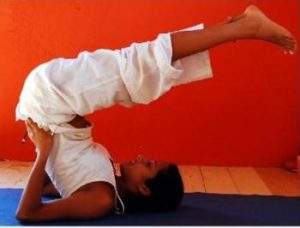In the first Blog about Bodhiyoga we explain in outline the basic concept which is Bodhiyoga.
This can be found on the website: www.bodhiyoga.es
In this blog we want to continue the exploration of the ideas behind Bodhiyoga so as to clarify what it is we are aiming at as teachers and students.
 In an nutshell we can describe the process of practice as an attempt to bring about and sustain more and more positivity and growth in our lives. This means more specifically, developing self awareness through practicing meditation, asana, relaxation and study to bring about deeper levels of self awareness so that we can learn to break free of habitually negative states of behaviour. On the positive side, we draw out deeper levels of creative responsiveness based in ethical behaviour and non-harm. We are the heirs of our states of mind and it is us that is responsible for our states of happiness or suffering, delusion or wisdom. Although we live in a world and that world influences us, we are non-the-less the ones that have to choose how we respond to that stimulus.
In an nutshell we can describe the process of practice as an attempt to bring about and sustain more and more positivity and growth in our lives. This means more specifically, developing self awareness through practicing meditation, asana, relaxation and study to bring about deeper levels of self awareness so that we can learn to break free of habitually negative states of behaviour. On the positive side, we draw out deeper levels of creative responsiveness based in ethical behaviour and non-harm. We are the heirs of our states of mind and it is us that is responsible for our states of happiness or suffering, delusion or wisdom. Although we live in a world and that world influences us, we are non-the-less the ones that have to choose how we respond to that stimulus.
Our teacher states that the first thing to do in the spiritual life is to become aware of oneself. The next thing is to become aware of oneself and lastly…one becomes aware of oneself. This triple utterance reinforces the need for AWARENESS in every moment of our lives.
It is curious that people put so much time and energy into looking after and maintaining the body, houses, cars and our children etc. But we generally as a society seem to pay little attention to the mind. We feed it all sorts of garbage – endless information and facts, endless streams of worry and anxiety. Then we wonder why we feel so out of balance, so stressed and perturbed.
Modern life has been characterised as the ‘age of anxiety’. Aptly referred to perhaps because along with our growing thirst for material development and financial security comes on the back, like a the wheel of a cart following the horse that is drawing it, all sorts of worries and insecurities.

So developing awareness is paramount. Of course, it is not only yoga and meditation and study of teachings that lead to this. We can develop awareness in all situations of our lives. These particular practices however, lend themselves strongly to the concentrated developing of those qualitiesthat we can then take into our everyday lives. When practiced in retreat, then the chances of our going deeper are taken much further as retreat is where we can really enter into ourselves and the practices, knowing that the environment is there to support and guide our efforts.
Bodhiyoga courses and teacher training aim to provide forums for the exploration and development of the participants using the core teachings of Buddhism combined with elements of classical hatha yoga. The teaching is definitely not confusing the teachings of Hinduism and Buddhism together, but rather taking the aspects of hatha yoga that are ‘religiously neutral’ and using them for the development of awareness that at the end of the day is a universal quality.
So bringing in explicit teachings on awareness and Buddhism as well as hatha yoga gives us the practical and theoretical teachings that we need in order to develop this human quality that we call awareness or mindfulness.
There are many different aspects the developing of mindfulness and it is this theme that we will turn to in our next blog. Next time we’ll look at these in more detail.

 In an nutshell we can describe the process of practice as an attempt to bring about and sustain more and more positivity and growth in our lives. This means more specifically, developing self awareness through practicing meditation, asana, relaxation and study to bring about deeper levels of self awareness so that we can learn to break free of habitually negative states of behaviour. On the positive side, we draw out deeper levels of creative responsiveness based in ethical behaviour and non-harm. We are the heirs of our states of mind and it is us that is responsible for our states of happiness or suffering, delusion or wisdom. Although we live in a world and that world influences us, we are non-the-less the ones that have to choose how we respond to that stimulus.
In an nutshell we can describe the process of practice as an attempt to bring about and sustain more and more positivity and growth in our lives. This means more specifically, developing self awareness through practicing meditation, asana, relaxation and study to bring about deeper levels of self awareness so that we can learn to break free of habitually negative states of behaviour. On the positive side, we draw out deeper levels of creative responsiveness based in ethical behaviour and non-harm. We are the heirs of our states of mind and it is us that is responsible for our states of happiness or suffering, delusion or wisdom. Although we live in a world and that world influences us, we are non-the-less the ones that have to choose how we respond to that stimulus.

